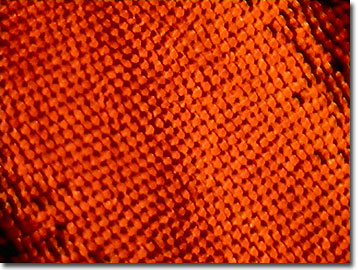Butterfly Wing Scale Digital Image Gallery
Longwing Butterfly
Longwing butterflies are extremely loyal to their host and food plant, the passionflower vine. The butterflies have unusually long lifespans and high fecundity rates, which largely result from their augmented diet. Instead of surviving on food stores from the larval stage or solely sipping flower nectar, adult longwing butterflies are avid pollen eaters.

Scientifically described as Heliconius xanthocles, the longwing butterfly ranges around the coastal plains of South America. Although it has an impressive elevation limit of about 1,000 meters, the elegant, but small species prefers the lower river valleys. A thin, elongate body, very long, slender black antennae, and a slow, lofty flight characterize the species. The loud black and orange coloration of its wings indicates that longwing butterflies are not just beautiful, but dangerous as well. The brightly colored species participates in Müllerian mimicry rings with several other noxious butterfly and moth species. Predators quickly learn to avoid the longwing butterfly and its copycats from the ill effects they experience when one is eaten.
The complex relationship between longwing butterflies and passionflower vines indicate that the species have closely coevolved. Longwing adults recognize passion vines by leaf shape, vine smell, and the taste of the leaves. In return for the nectar and pollen they consume, longwing adults pollinate passionflower vines. Nevertheless, the plant does its best to minimize the number of longwings that may survive on its vines. Passionflowers produce small glands known as foliar nectaries that resemble the barrel-shaped golden eggs of the longwing butterfly. The nectaries often discourage female longwings from laying eggs on a particular plant because the vines already appear occupied. The nectaries also act as attractants for coevolved ants that prey on longwing caterpillars and eggs. The larvae that manage to survive are able to sequester cyanide-like chemicals from the passionflower vine, which they use as their own personal defense system.
Sold as live chrysalides and dry adults, the longwing butterfly species is part of the international butterfly trade and is reared in butterfly conservatories worldwide. The graceful lepidopteran and its congenerics are particularly susceptible to capture because they are slow fliers that often feed for long periods of time on a single flowering plant and follow a set route day after day. Air and water pollution, rampant development, deforestation, hydroelectric power dams, and pesticide usage in South America are also problematic for longwing butterflies and their indispensable passionflower vines.
Contributing Authors
Cynthia D. Kelly, Shannon H. Neaves, Laurence D. Zuckerman, and Michael W. Davidson - National High Magnetic Field Laboratory, 1800 East Paul Dirac Dr., The Florida State University, Tallahassee, Florida, 32310.
BACK TO THE BUTTERFLY WING SCALE IMAGE GALLERY
BACK TO THE DIGITAL IMAGE GALLERIES
Questions or comments? Send us an email.
© 1995-2025 by Michael W. Davidson and The Florida State University. All Rights Reserved. No images, graphics, software, scripts, or applets may be reproduced or used in any manner without permission from the copyright holders. Use of this website means you agree to all of the Legal Terms and Conditions set forth by the owners.
This website is maintained by our
Graphics & Web Programming Team
in collaboration with Optical Microscopy at the
National High Magnetic Field Laboratory.
Last Modification Friday, Nov 13, 2015 at 01:19 PM
Access Count Since January 21, 2003: 10178
Visit the website of our partner in introductory microscopy education:
|
|
